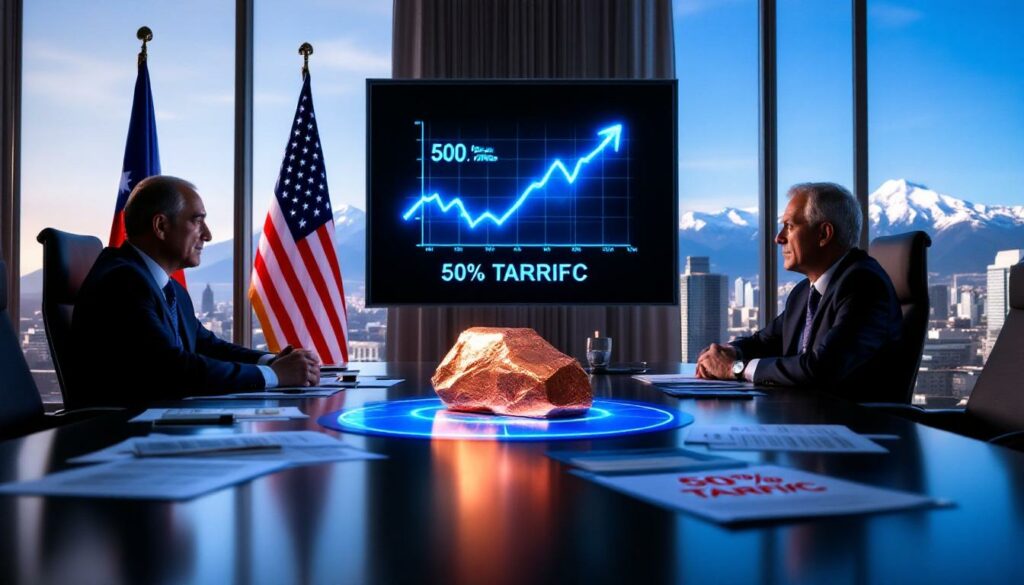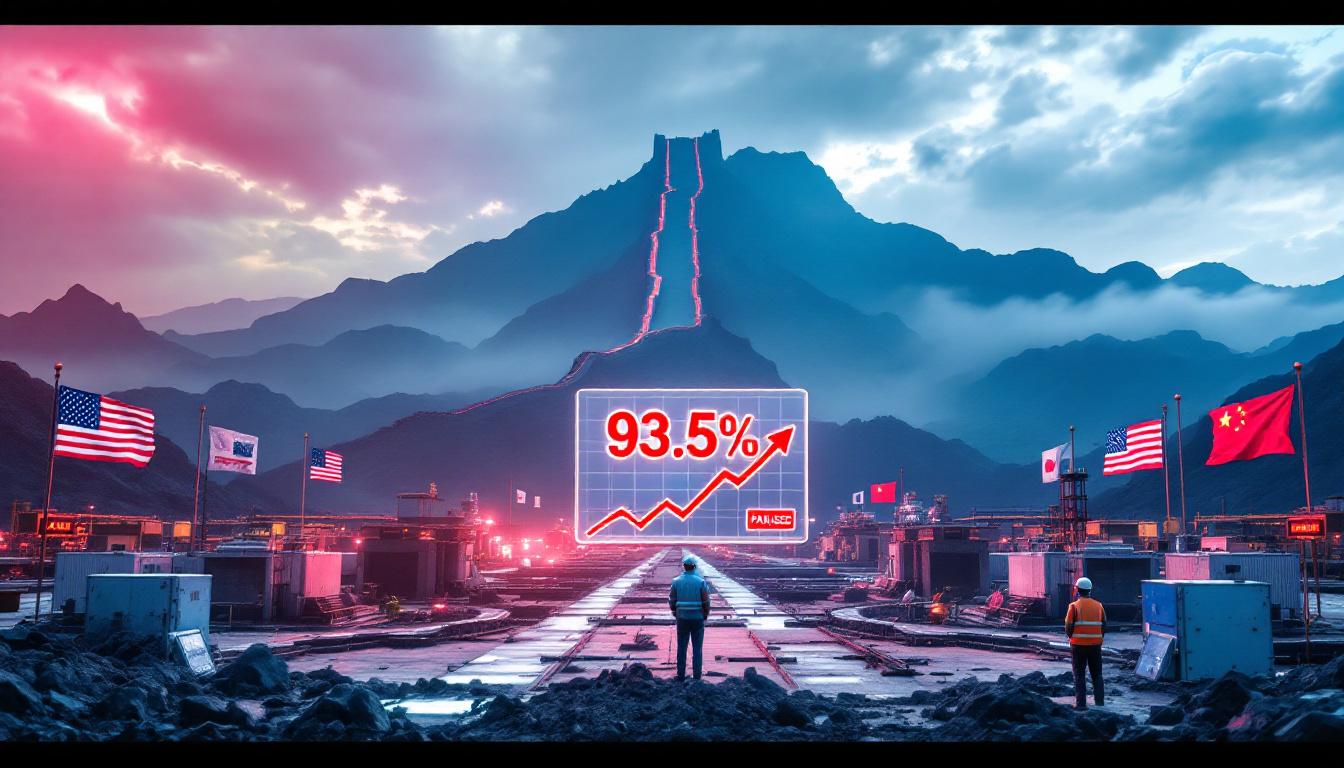Chile Will Ask US to Include Copper Within Broader Trade Talks
The diplomatic dialogue between Chile and the United States over copper trade has intensified amid proposed tariffs on the red metal. As negotiations continue, both countries are navigating complex economic interests while global markets watch closely for the outcome of these high-stakes discussions.
Current State of Chile-US Copper Trade Relations
Chile, the world's largest copper producer, finds itself at a critical juncture in its trade relationship with the United States. The proposed 50% tariff on copper imports threatens to disrupt a long-established trade partnership and could significantly impact Chile's economy, which relies heavily on copper exports.
Proposed US Tariff Impact
The Trump administration's announcement of a 50% tariff on copper imports, set to take effect on August 1, 2025, has sent shockwaves through global markets. According to MINING.com, copper futures on COMEX dropped approximately 3% to $5.613 per pound on July 28, 2025, as investors responded to the tariff uncertainty.
As the world's largest copper producer and the primary supplier of refined copper to the United States, Chile stands to lose significantly if these tariffs are implemented without exemptions or modifications. The South American nation exports substantial volumes to both the US and China, with China currently receiving the larger share of Chile's copper output.
The proposed tariffs would create an immediate challenge for Chile's export-dependent economy, potentially reducing competitiveness of Chilean copper in the US market and forcing producers to seek alternative buyers or accept lower margins.
Ongoing Negotiation Timeline
The third round of talks between Chilean officials and the US Trade Representative began on July 28, 2025. These discussions represent a critical opportunity for Chile to secure favorable terms before the tariff deadline.
Previous negotiation attempts have yielded limited progress, with both sides maintaining their positions on key issues. Chilean Finance Minister Mario Marcel has emerged as a central figure in these talks, advocating for Chile's copper interests while seeking to preserve the broader trade relationship.
"We want [copper] to be part of the agreement, within the broader commercial discussions — not something handled separately — because it's a very central issue," Marcel stated, according to MINING.com reporting from the negotiation site.
Key stakeholders in these discussions include Chile's economic ministers, mining industry representatives, and their US counterparts focused on trade policy and national security considerations related to critical minerals.
Why Is Chile Seeking Copper Inclusion in Broader Trade Talks?
Chile's approach to these negotiations reflects a strategic calculation: by integrating copper into comprehensive trade discussions, the country hopes to leverage its overall trade relationship with the US rather than allowing copper to be isolated as a separate issue subject to punitive tariffs.
Strategic Importance of Copper to Chile's Economy
Copper represents more than half of Chile's exports to the United States, making it the cornerstone of bilateral trade between the nations. This heavy reliance on a single commodity creates significant economic vulnerability for Chile if access to the US market becomes restricted or economically unviable due to tariffs.
The Chilean copper industry directly employs approximately 200,000 workers and indirectly supports hundreds of thousands more jobs throughout the country. Regions like Atacama and Antofagasta are particularly dependent on mining activity, with copper accounting for 10-15% of Chile's GDP during market boom periods.
Marcel highlighted this dependency when he noted that "a trade agreement that excludes more than half of our exports to the US, such as copper and wood, wouldn't be very useful." This statement underscores Chile's determination to ensure copper remains central to any trade discussions.
Chile's Negotiation Strategy
Chile's approach differs notably from other countries that have sought standalone exemptions from US tariffs. Rather than requesting special treatment for copper alone, Chilean officials have consistently advocated for incorporating copper into a comprehensive trade framework.
This strategy reflects both pragmatic and principled considerations. On the practical side, Chile recognizes that copper's economic significance gives it negotiating leverage that might be diluted if discussed in isolation. From a principled standpoint, Chile seeks to reinforce the rules-based trading system rather than accepting piecemeal exceptions.
Other nations have had mixed success with similar approaches. For instance, South Korea secured steel tariff exemptions in exchange for accepting export quotas during previous US trade negotiations. Chile appears to be studying these precedents while developing its own unique approach tailored to its copper-centric trade profile.
How Would US Copper Tariffs Affect Global Markets?
The potential implementation of 50% tariffs on copper imports would trigger significant adjustments throughout global supply chains and trading patterns, creating both winners and losers in the international copper market.
Market Reactions to Tariff Announcements
Financial markets have already demonstrated sensitivity to tariff news, with copper prices experiencing noticeable volatility. The 3% drop to $5.613 per pound on COMEX following recent tariff discussions illustrates investor concerns about demand disruption in the world's largest economy.
This uncertainty has prompted many market participants to adopt a wait-and-see approach ahead of the August 1 deadline. Mining companies with significant exposure to the US market have seen their stock prices fluctuate as analysts attempt to model various tariff scenarios and their potential impact on profitability.
For US manufacturers, the prospect of substantially higher copper input costs creates significant planning challenges. Industries relying heavily on copper—including electrical equipment, construction, and electronics—face potential cost increases that could ultimately be passed to consumers, potentially dampening demand.
Global Copper Supply Chain Realignment
If tariffs are implemented, Chile's export patterns would likely undergo significant adjustments. While specific export distribution figures require validation from sources like COMINTEX or the International Copper Study Group, industry analysts suggest Chile could redirect substantial volumes toward China and other Asian markets.
This redirection would potentially benefit competing copper-producing nations that might secure exemptions or face lower tariff barriers. Peru, as the world's second-largest copper producer, and Australia could gain market share in the US, though their combined production capacity would struggle to fully replace Chilean supply in the near term.
The tariffs could also accelerate interest in copper recycling and scrap recovery within the United States, potentially boosting the circular economy for this crucial metal. However, domestic recycling infrastructure would require significant expansion to meaningfully offset import reductions.
What Are the Broader Trade Implications Beyond Copper?
While copper dominates headlines, the current trade tensions between Chile and the US encompass additional products and reflect broader shifts in international trade dynamics.
Additional Products Under Discussion
Wood exports represent another significant category in Chile-US trade that could be affected by changing tariff structures. Though secondary to copper in economic importance, wood products provide crucial diversification for Chile's export portfolio.
Other Chilean exports to the US include agricultural products, wine, and seafood, each with their own stakeholder communities and economic significance. These sectors are watching the copper negotiations closely for indications of how their own products might be treated in future trade arrangements.
Chile's economy, while more diversified than many resource-dependent nations, still faces challenges in developing high-value exports beyond its traditional commodity strengths. The current trade tensions highlight both the benefits and risks of Chile's export composition.
Geopolitical Context of US-Chile Relations
The current negotiations unfold against the backdrop of a historically positive US-Chile relationship, anchored by the 2004 US-Chile Free Trade Agreement. This agreement eliminated most tariffs between the countries and established cooperative mechanisms that have facilitated trade for nearly two decades.
Strategic minerals security has gained prominence in US policy discussions, with copper recognized as essential for renewable energy infrastructure, electronics, and defense applications. This recognition creates potential common ground for negotiators seeking mutually beneficial outcomes.
Within Latin America, these negotiations are being closely watched as a potential indicator of broader US trade policy toward the region. Other copper-producing nations, particularly Peru, are assessing how the US-Chile resolution might affect their own export strategies.
How Might These Negotiations Resolve?
Several potential pathways to resolution exist, each with different implications for both countries and the global copper market.
Potential Compromise Scenarios
Based on previous trade negotiations, several compromise scenarios appear plausible:
-
Quota System: Chile might accept volume limitations on tariff-free copper exports to the US, similar to arrangements negotiated with South Korea on steel exports.
-
Phased Tariff Reduction: A schedule gradually decreasing tariffs over several years could provide time for market adjustment while offering immediate relief.
-
Product-Specific Carve-Outs: Certain copper products critical to US manufacturing might receive exemptions while others face full tariffs.
-
Bilateral Investment Commitments: Chile could commit to facilitating US investment in its copper industry in exchange for favorable tariff treatment.
Previous trade disputes suggest that face-saving compromises often emerge close to implementation deadlines, allowing both sides to claim victories on their priority issues.
Timeline for Resolution
With the August 1, 2025, implementation date approaching, negotiators face significant time pressure. If an agreement cannot be reached before this deadline, contingency plans would need to be activated by both Chilean producers and US importers.
The implementation of any eventual agreement would require careful monitoring, likely with dispute resolution mechanisms similar to those in the existing US-Chile FTA. Such mechanisms typically include regular consultations, data sharing, and procedures for addressing compliance concerns.
Both countries have strong incentives to avoid a prolonged trade dispute that could damage their broader economic relationship and create uncertainty for businesses and investors.
What Does This Mean for the Global Copper Industry?
Beyond the immediate negotiation outcomes, these tariff discussions signal potential longer-term shifts in global copper production, investment, and sustainability practices.
Long-term Investment Implications
Major mining projects in Chile, such as the $5.5 billion Quebrada Blanca Phase 2 expansion, require stable market access and predictable pricing to justify their substantial capital requirements. Prolonged trade uncertainty could delay investment decisions or shift capital toward projects in countries with more secure US market access.
The global copper production landscape could evolve in response to these trade dynamics, with companies diversifying their geographic footprints to mitigate market access risks. This might accelerate development in emerging copper regions like Ecuador or the Democratic Republic of Congo, despite their higher operational risks.
Investment strategies are also adapting to this uncertainty, with mining companies increasingly focusing on portfolio diversification, financial flexibility, and partnerships that can help navigate complex trade environments.
Sustainability and ESG Considerations
Environmental standards vary significantly across copper-producing regions, creating potential sustainability implications if production shifts to areas with less stringent regulations. Chile's copper industry has made substantial progress in renewable energy adoption, with many operations transitioning to solar and wind power.
"Chile's copper industry is increasingly powered by renewable energy, with several major mines sourcing over 50% of their electricity from solar installations in the Atacama Desert," notes a recent sustainability report from Chile's mining council.
The carbon footprint implications of supply chain realignment deserve careful consideration, as longer transportation routes or production in coal-dependent regions could increase the overall environmental impact of copper consumption.
Social responsibility aspects also factor into trade policy decisions, with labor practices, community relations, and indigenous rights varying significantly across copper-producing regions. As supply chains adjust to new trade realities, maintaining robust ESG standards throughout the copper value chain will remain a key industry challenge.
FAQs About Chile-US Copper Trade Negotiations
How significant is Chilean copper to US supply chains?
Chile currently serves as the largest provider of refined copper to the United States, making it a critical supplier for American manufacturing and infrastructure development. According to trade data, Chilean copper is particularly important for electrical applications, construction, and renewable energy infrastructure, sectors that are expected to see growing demand in coming years.
What alternatives does the US have to Chilean copper?
The US could potentially increase domestic production, source from other copper-producing nations like Peru or Australia, or develop recycling programs, though each alternative presents its own challenges. Domestic production faces permitting hurdles and higher operational costs, while alternative suppliers may lack Chile's production scale or quality consistency. Recycling offers promise but would require significant investment in recovery infrastructure.
How might these tariffs affect copper prices for consumers?
If implemented, the 50% tariffs would likely increase costs for US manufacturers, potentially leading to higher prices for consumer electronics, electrical infrastructure, and construction materials. The extent of price increases would depend on manufacturers' ability to absorb costs or find alternative suppliers, but analysts suggest price increases of 5-15% could reach consumers in copper-intensive products.
What precedents exist for resolving similar trade disputes?
Previous metal tariff disputes have been resolved through quota systems, targeted exemptions, or inclusion in broader trade agreements. For example, the US-Korea steel tariff resolution involved volume quotas that allowed duty-free access up to specified limits. Similar mechanisms could provide templates for the copper negotiations, though each commodity market has unique characteristics requiring tailored approaches.
How do these negotiations connect to broader US trade policy?
The copper tariff proposal aligns with broader protectionist trade measures being implemented by the Trump administration, reflecting a shift in US trade policy priorities. This approach emphasizes bilateral negotiations over multilateral frameworks and uses tariffs as leverage to secure specific economic or strategic objectives. The outcome of these copper negotiations could signal the administration's approach to other commodity-specific trade issues.
Further Exploration:
Readers interested in learning more about Chile-US copper trade relations can also explore related educational content available at MINING.com, which offers additional perspectives on global copper markets and trade policy developments.
Ready to Gain Early Access to the Next Major Mineral Discovery?
Discover how significant ASX mineral discoveries can deliver exceptional market returns by exploring Discovery Alert's proprietary Discovery IQ model, which turns complex announcements into actionable insights. Begin your 30-day free trial today at Discovery Alert's discoveries page and position yourself ahead of the market.




